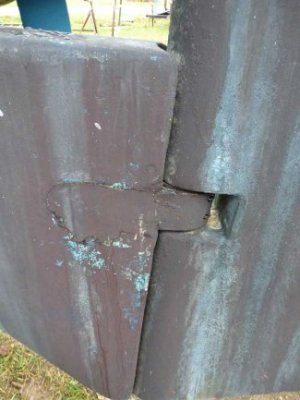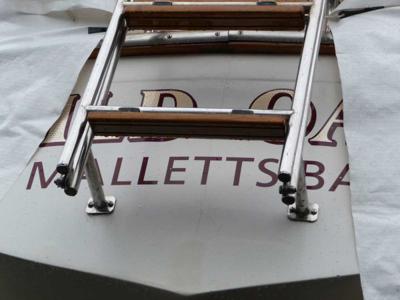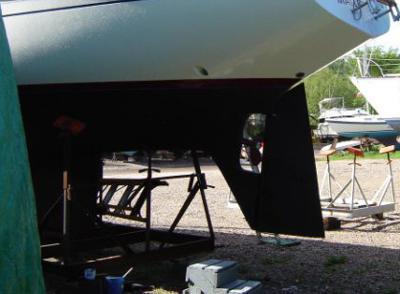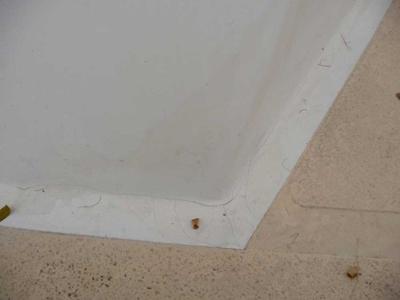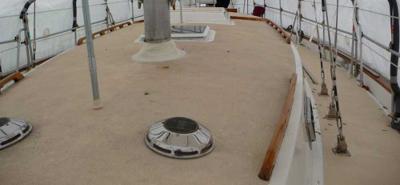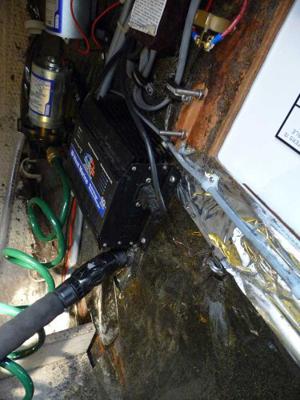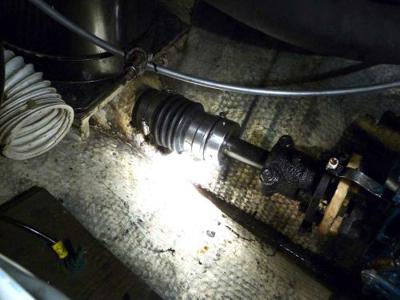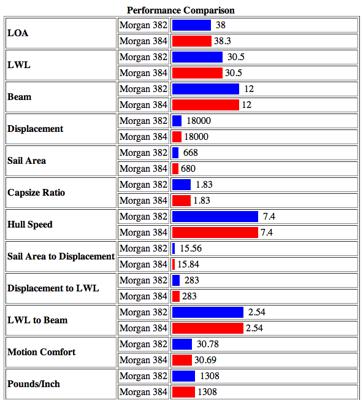Weather helm is a result of having to much sail up in the fore triangle or moving the center of effort forward.
"Weather helm is the tendency of sailing vessels to turn towards the source of wind, creating an unbalanced helm that requires pulling the tiller to windward (i.e. 'to weather') in order to counteract the effect. Weather helm is the opposite of lee helm.
When a vessel is close hauled and heeling, the lee side of the hull is more under water than the weather side. The resulting shape of the submerged part of the hull in this condition usually creates a force (a turning moment) that pushes the bow to weather so that it is necessary to pull the tiller to weather to equilibrate this force. Since a weather helm requires pulling the rudder through the water at an angle to the intended course, it produces drag and retards the boat's progress through the water. In the book "Sailing Illustrated", Patrick M. Royce defines weather helm as simply a "heeling sailboat wanting to come head to wind."[1] The principle is the same whether the vessel is steered by tiller or wheel; turning the wheel leeward gives the same rudder effect as pulling a tiller windward.
[edit] Mitigation
Any action that reduces the angle of heel of a boat that is reaching or beating to windward will help reduce excessing weather helm. Racing sailors routinely try to use bodyweight or other moveable ballast to bring the boat to a more upright position. Reducing or reefing the total sail area will have the same effect and, counter-intuitively, many boats will sail faster with less sail in a stiff breeze once heel and weather helm have been reduced, due to the reduction in underwater drag. Easing the sheets on aft-most sails, such as the mainsail in a sloop or cutter can have an immediate effect, especially to help with manoeuvering. Moving or increasing sail area forward can also help, for example by raising the jib (and maybe lowering the staysail) on a cutter.
Sailing off the wind, weather helm may be caused by the imbalance due to fore-and-aft sails all being sheeted out on the same (leeward) side of the boat. Raising a spinnaker or poling out a headsail to windward with a whisker pole can help. Yachts making ocean trade wind crossings have rigged 'twins' - double headsails poled out to opposite sides from the same forestay for extended downwind passages without a mainsail.[2] Square rigged sails also provide relatively symmetric drive off the wind.
[edit] Discussion
See Sailing Theory and Practice by C.A. Marchaj for a mathematical analysis of the dynamics of weather helm.[3]
While it is true that an increased angle of heel generally increases weather helm, it is misleading to identify heel as the cause of weather helm. The fundamental cause of "helm", be it weather or lee, is the relationship of the center of pressure of the sail plan to the center of lateral resistance of the hull. If the center of pressure is astern of the center of lateral resistance, a weather helm, the tendency of the vessel to want to turn into the wind, or to weather-vane, will result. A slight amount of weather helm is thought by many skippers to be a desirable situation, both from the standpoint of the "feel" of the helm, and the tendency of the boat to head slightly to windward in stronger gusts, to some extent self-feathering the sails. It also provides a form of dead man's switch'the boat stops safely in irons if the helm is released for a length of time.
If the situation is reversed, with the center of pressure forward of the center of resistance of the hull, a "lee" helm will result, which is generally considered undesirable, if not dangerous. Too much of either helm is not good, since it forces the helmsman to hold the rudder deflected to counter it, thus inducing extra drag beyond what a vessel with neutral or minimal helm would experience.
To be fair, if a ship was initially well-balanced in respect to helm, it could be said that heeling might "cause" a weather helm, in the sense that the heel could create one that did not exist before, but this obscures the fact that the root cause of the phenomenon is the relationship between the center of the force exerted by the sail plan, and the center of the resistance to that force by the hull, and not the angle of heel of the hull."
The rudder modification done on later models did little to enlarge the rudder where it is needed and that is lower in the water and away from surface turbulence.
The mast being raised and boom shorten, I was told, was a result of charter people complaining of the low boom and traveler in the cockpit.
Reefing the main or reducing the size of the headsail will help balance the boat and therefore increase speed and comfort for the crew. My sailmaker said the ideal headsail for the 382 is either a 90 or possibly a 100. A larger, 110 or 120, only makes sense for sailing areas with light air. Even with the 90 or 100, reefing the main should done in approx. 15 to 18 kts.
Jim


